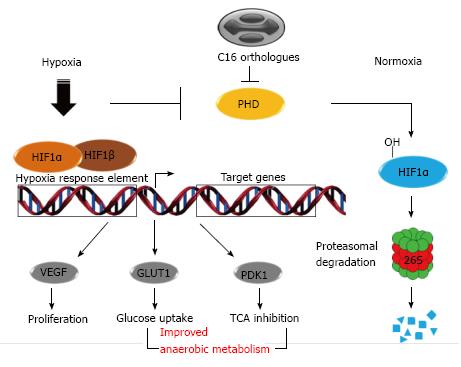Copyright
©2014 Baishideng Publishing Group Inc.
World J Clin Infect Dis. Nov 25, 2014; 4(4): 27-40
Published online Nov 25, 2014. doi: 10.5495/wjcid.v4.i4.27
Published online Nov 25, 2014. doi: 10.5495/wjcid.v4.i4.27
Figure 3 Hypoxic responses in poxviruses infected cells.
Under normal O2 disponibility (normoxia), HIF1α is hydroxylated on proline residues by PHDs. After that, HIF1α is recognized and ubiquitinated by E3 ubiquitin ligase and undergoes proteasomal degradation. Upon an insufficient O2 availability (hypoxia), PHD become inactive and HIF1α forms heterodimers with HIF1β and triggers expression of regulators of TCA, cell proliferation and glucose metabolism. Poxviruses C16L orthologous genes code for proteins that inhibit PHD activities and result in expression of hypoxia target genes under normoxia conditions. HIF1: Hypoxia-inducible factor-1; PHD: Prolyl-hydroxylase domain-containing enzyme; TCA: Tricarboxylic acid cycle; VEGF: Endothelial growth factor; GLUT1: Glucose transporter-1; PDK1: Pyruvate dehydrogenase kinase-1.
- Citation: Leão TL, da Fonseca FG. Subversion of cellular stress responses by poxviruses. World J Clin Infect Dis 2014; 4(4): 27-40
- URL: https://www.wjgnet.com/2220-3176/full/v4/i4/27.htm
- DOI: https://dx.doi.org/10.5495/wjcid.v4.i4.27









